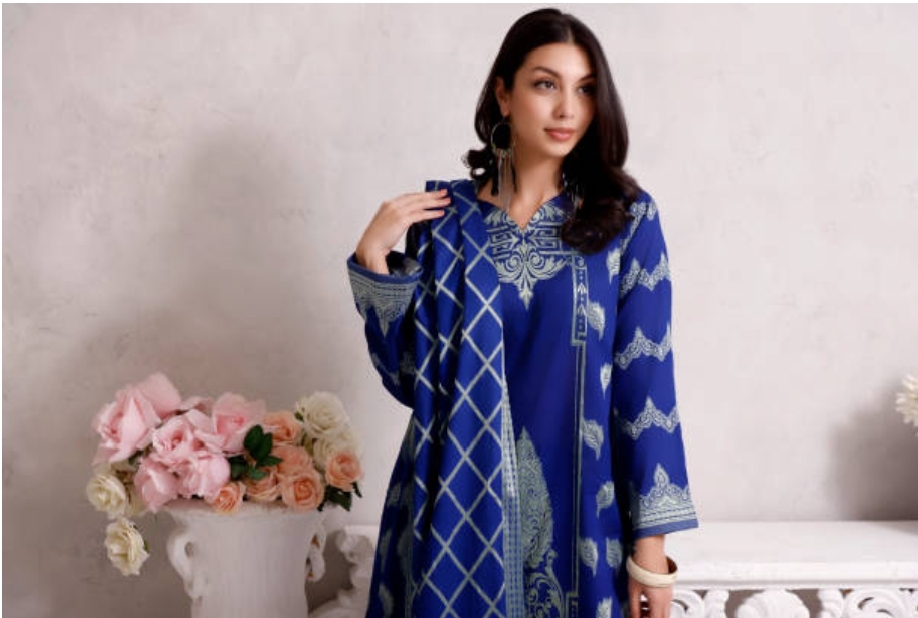Pakistani dresses are a combination of history, culture, and art. Across the world, this apparel has become the craze among fashion lovers. Rich colors, minute detailing, and richly textured fabrics-the key point of Pakistani clothing denotes a country with history. However, it also demonstrates how the culture is constantly growing. Collections like Maria.B. Unstitched highlight how traditional styles can be given a modern touch. This blog will explore the traditional beauty of Pakistani clothes and the key elements that make them so special and beloved.
Cultural Significance
Pakistani clothes represent more than just fashion. It represents the country’s diverse cultural heritage. Each region in Pakistan has its own distinct style. These styles are influenced by the region’s history, climate, and customs.
The Punjab region is well-known for its colorful Shalwar Kameez. These clothes are frequently adorned with gorgeous embroidery and accessories. In contrast, the Sindh region loves the Ajrak. This is a block-printed shawl with geometric patterns. It represents the rich textile printing tradition that dates back to the Indus Valley Civilization.
In the northern regions of Pakistan, like Khyber Pakhtunkhwa and Gilgit-Baltistan, traditional dresses often use woolen fabrics. These dresses also feature handwoven designs. This represents the colder climate and demonstrates the craftsmanship passed down through generations. Every piece of clothes has a story. It depicts Pakistan’s cultural variety in a bright and tangible manner.
Elegance of Handcrafted Embroidery
Pakistani clothes are known for such delicate needlework that has been a capability honed for generations. Every region has their own fashion: Punjab has Chikankari, Balochi mirror work, and Sindhi’s motifs in brights. The craftsmanship is excellent.
Chikankari is a traditional Mughal kind of embroidery which is ages-old. It generally has very fine flower motifs and intricate embellishments. This is conventionally done on light textiles such as cotton and muslin. These textiles are perfect for South Asia’s hot, humid climate.
In Balochistan, traditional attire features mirror work and vibrant embroidery. These designs are not only beautiful but also culturally significant. They often depict motifs of nature, fertility, and protection. Another example of Pakistan’s rich textile heritage is the Ghara embroidery of Sindh. It showcases bold, colorful patterns that are a key part of traditional Sindhi dress.
The Richness of Pakistani Fabrics
Pakistani clothing is recognized for its rich textiles. These textiles improve the beauty and attraction of the clothes. Silk, chiffon, lawn, and cotton are examples of often used materials. Each one offers a unique texture, weight, and drape.
Lawn fabric is known worldwide for its softness and breathability. This makes it perfect for the hot summers in Pakistan. Lawn suits are popular because they have gorgeous designs and embroidery. They have become a must-have in women’s wardrobes across Pakistan and beyond.
Formal events are also meant for silk and chiffon because of the luxurious feel they have while wearing and falling. This may be segregated in Lehengas, Sarees, and Anarkalis. Usually, any Indian wedding or special occasions are meant to wear this outfit. The richness of the fabric, silk, and chiffon merged with heavy embroidering and embellishments make them really special outfits.
The Versatility of Pakistani Fashion
The adaptability with which it can fit traditional garb makes Pakistani attire one of the most alluring. It can turn it into a casual day out, a jubilant celebration, or a formal function.
Shalwar Kameez is worn for daily purposes as it is comfortable and handy to wear. It comprises a long, body-length shirt known as a kameez along with loose-fitting pants known as shalwar. It can range from very casual to being worn at weddings or festivals with the addition of more intricate embroidery.
Saree and Lehenga Choli are eternal options when it comes to formal wear. Worn on grand occasions such as weddings and festivals, these clothes-usually made from very expensive materials like silk and chiffon-are embossed with embroidery and other elaborate embellishments. Being versatile outfits, they provide scope for a lot of permutations and combinations that ensure every lady wearing them can distinctly reflect her personal style while maintaining allegiance to traditional values.
Preserving Tradition in Modern Times
Even as Western fashion trends become more popular, many people still value traditional Pakistani clothes. Designers are always updating these classic styles. They mix traditional elements with modern fashion to suit today’s tastes.
The rise of fusion apparel exemplifies the blending of old and new. Traditional outfits, such as the shalwar kameez, are getting a modern makeover. These outfits have current cuts, prints, and accessories. This trend helps keep tradition alive. It also makes it appealing to a younger generation. They want to embrace their cultural heritage in a modern way.
Conclusion
Pakistani clothing represents history, culture, and craftsmanship. Each piece highlights Pakistan’s rich tradition, featuring brilliant colors, beautiful needlework, and luxury fabrics. They combine the past with the present, making them an elegant and meaningful choice for any occasion.


